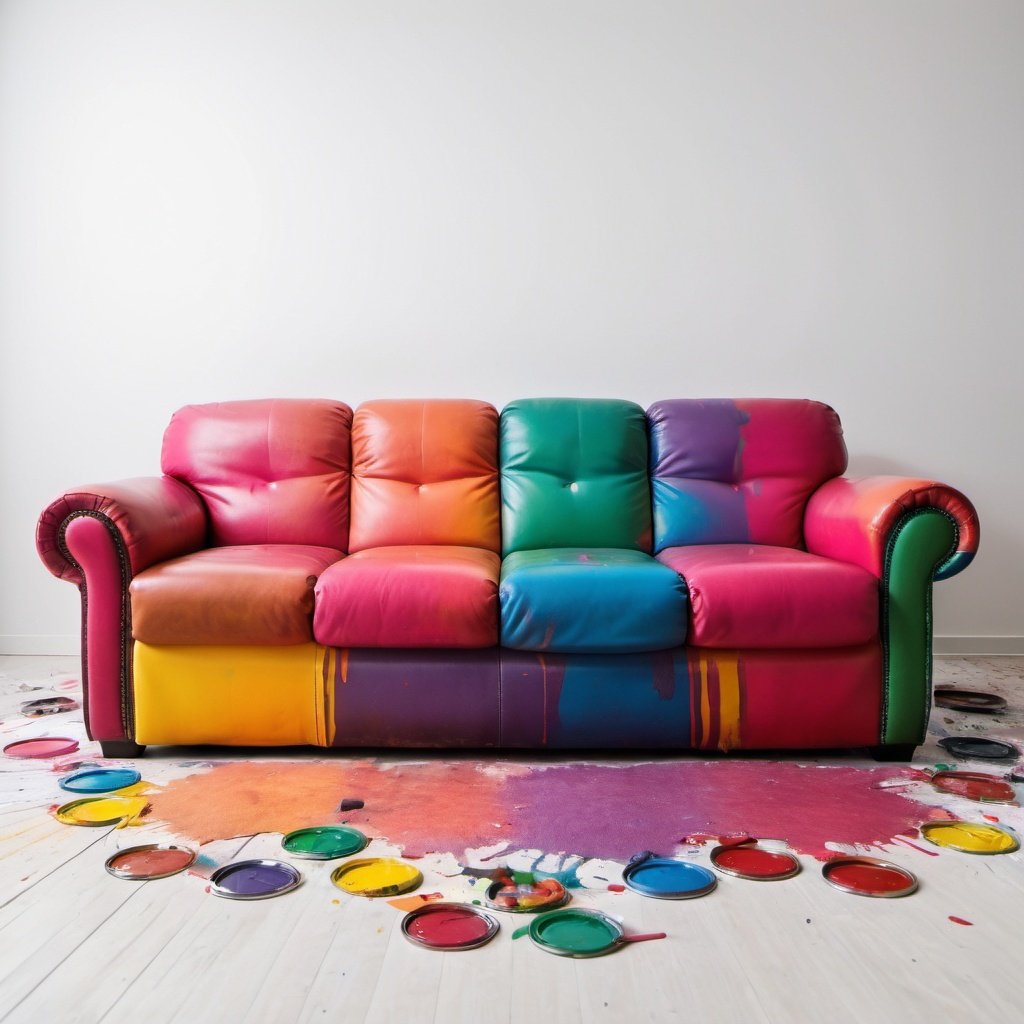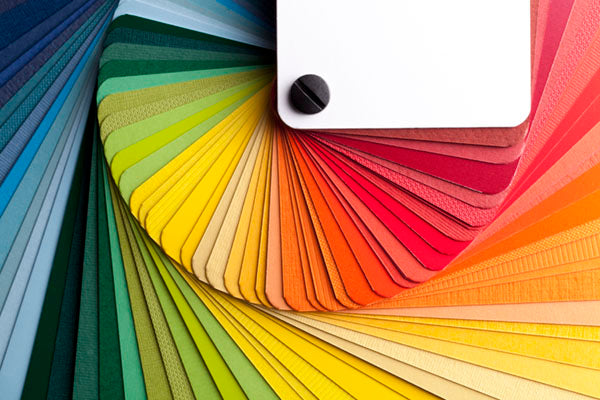Here we will go over how to restore and repair a very worn leather sofa made of dyed/pigmented leather, and make it look like new.
We will show you how to fill in scratches and cracks in the leather. We then dye the leather with leather dye and through this we restore the leather sofa to almost new condition. This type of restoration is done on top-dyed leather, or as it is also called, pigmented leather. It is a type of leather where the leather color and leather finish are on top of the leather's surface. The leather is not dyed through. This type of leather is very common on furniture and car upholstery. If you are unsure what type of leather your furniture has, you can read more about different leather types in our guide that you can find here.
We will now restore and repair the worn leather sofa below, to show you step-by-step how to proceed. Of course, you can also use the guide as a guide when restoring leather & hides on other types of leather furniture, or on leather car upholstery, as well as all other products made of dyed/pigmented leather. Here, however, we focus on repairing the leather sofa below. Stay tuned!
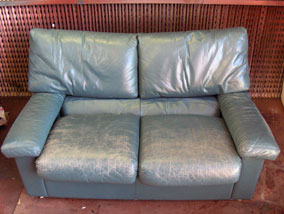
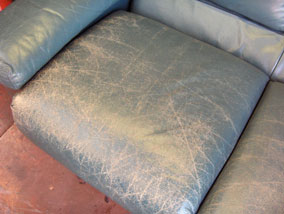
Step 1 – Cleaning and preparing the leather
The first and most important thing to do is to clean and prepare the leather for dyeing. In addition to everyday dirt from skin and clothing and the surrounding air, the leather sofa may have been treated with various different agents over the years; leather conditioner, leather oils, waxes containing silicone and other substances that have both settled on top of the leather's surface and penetrated the leather's pores and filled them up. If this is not removed from the leather's surface, the dye will have difficulty penetrating and adhering properly. It is therefore very important that the leather's surface is cleaned and prepared properly.
During the preparation process, we also remove the original surface finish of the leather. For this purpose, we use Leather Prep. In the pictures above you can see that the surface finish of the leather has cracks and crazing, a large part of these will disappear when the leather is “prepped”. The leather is very worn and cracked so we will also use Leather Binder, Heavy Filler Leather Filler and Leather Colourant when we carry out the restoration. If the leather has no cracks, or only a few, then Heavy Filler leather filler is not needed.
Always start with the back and sides. It is common for this to be a different type of leather, a split leather with a polyurethane surface (plastic) applied, or even artificial leather (which is made entirely of vinyl/plastic). These surfaces are more delicate and you should not use Leather Prep here, as it can damage the surface. It is enough to first clean with Ultra Clean and then wipe with a cloth dampened with Alcohol Cleaner. Not using Leather Prep on the sides and back will not affect the end result, as these areas are not actually used and therefore not “stressed”.
Since seat cushions, back and armrests are used in a different way, are worn and exposed to stress, it is important that the leather on them is properly prepared. For this purpose, we normally use a scotchbrite (square, green polishing cloth) and Leather Prep. to sand away the old surface finish and smooth out cracks and scratches. The leather is sufficiently “prepped” when the sanding cloth or rag you are using begins to become stained by the color of the leather. This means that the surface finish has been removed and the colored surface underneath is exposed.
But since the sofa in this case is so worn (the paint/finish is already worn away), we are content to wipe the leather thoroughly with Leather Prep on a cloth. This way we avoid damaging the leather further.
The above procedure has removed the manufacturer's original surface finish, as well as any silicone that is solvent-based. However, there are silicones that are not solvent-based and we need to remove these as well. For this we use Alcohol Cleaner/Silcone Remover. After the "prep", you therefore wipe the leather with a cloth dampened in Alcohol Cleaner/Silicone Remover. Then wait for 30 minutes while the prep and alcohol evaporate.
Step 2 – Repair cracks and worn areas
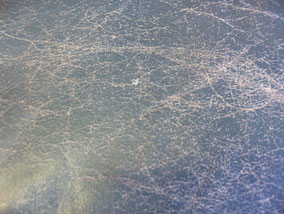
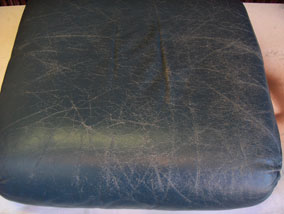
The pictures above show the poor condition of the seat cushions. The close-up on the right shows how more than twenty years of untreated wear and tear have caused the surface layer of the sofa cushions to crack as a result of the leather becoming dry and brittle. If the leather had been treated over the years with, for example, Leather Protection Cream, this could have been avoided.
We will now reinforce the worn areas and fill in the scratches. First we apply Leather Binder with a sponge. Leather Binder is a binder that pulls together and strengthens the leather fibers. It will also prevent the leather from cracking again in the future. Apply 3-5 coats of Leather Binder, letting it dry between each coat. In addition to Leather Binder penetrating and strengthening the leather, it builds up a surface layer on top of the leather and strengthens it. NOTE, Leather Binder can accumulate around and on the seams, remember to remove excess before the binder dries.
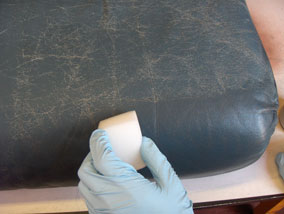
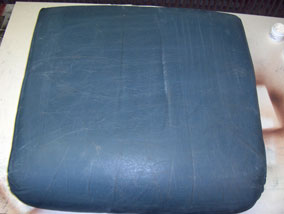
The leather will change appearance as the Binder is applied. In the case above, it looks as if the Binder has dyed the cracks. What has happened is that the leather has darkened as it has absorbed the binder. However, we are not done with the cracks yet. Now we will fill them with Heavy Filler leather filler.
Step 3 – Fill cracks with Heavy Filler Leather Filler
After we have applied Leather Binder to reinforce the worn leather and prevent it from cracking again in the future, it is now time to repair the leather sofa by filling the existing cracks with Heavy Filler . Heavy Filler is not suitable for filling holes or burn marks, for this there are other methods (see below the post “Instructional videos” , and e.g. in “Guide to repairing burn holes” ).
To fill the cracks with Heavy Filler leather putty, use a putty knife or palette knife . Be careful to remove any excess putty that has ended up outside the cracks. When all cracks are filled, let the leather putty dry for 30 minutes (the drying process can be sped up slightly with a hair dryer). The filler/putty may sink slightly during the drying process, so add additional layers of leather putty until you are satisfied. Make sure it dries between each layer. Then sand the filled surface with fine sandpaper (800-1200) until it feels smooth and even.
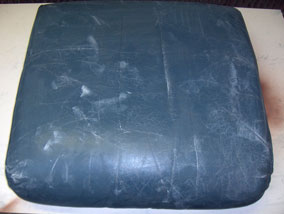
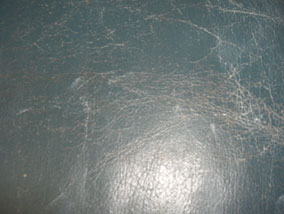
In the pictures above you can see that some cracks are filled with leather putty and other areas are treated with Binder. We recommend applying a layer of Binder on top of the putty, this is to get the same surface texture on the areas that are putty as on the surrounding surface.
Step 4 – Dyeing the leather
Shake the bottle of Leather Colourant for a few minutes to make sure it is thoroughly mixed. The colour is quite thick, but is thixotopic and thins out when shaken. If, despite shaking, it feels too thick, you can dilute the colour with a few drops of plain water. Then pour a small amount of leather colour onto a sponge and rub the colour into the leather. Press lightly so that the leather colour penetrates the fibres of the leather properly. If you press too hard, a foam may form, but this is not dangerous, just make sure to carefully wipe it off before the colour dries.
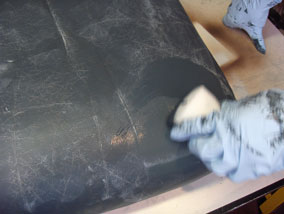
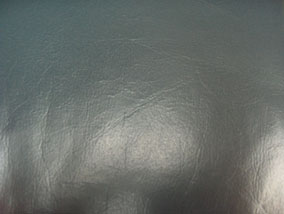
The idea is that we will use the sponge to apply a first layer of leather paint in all the folds and places where it is difficult to reach with a sprayer. You can then choose whether you want to continue sponging all the layers, or if you want to spray the leather paint with a paint sprayer/airbrush. The picture above on the right shows what it looks like with a layer of leather paint sponged onto the surface. After the paint has dried, you can sponge on additional layers of leather paint. Note that it is important to “dab” the paint starting with the second layer; if you don’t do this, but drag the sponge, there is a risk that the first layer will come off the surface of the leather, and the result will be like applying the first layer of paint over and over again.
If you have access to a paint sprayer, finish by spraying at least one coat of paint. Make sure the sprayer is at the right distance from the surface to be sprayed, and then spray a thin coat on small areas at a time. Dry the applied paint with a hair dryer, this is to prevent the paint from running. Practice on a piece of paper first to get the “right crease”. Should the paint still run, soak up the run with a sponge and spray on another coat. It is important to let the paint dry between each applied coat.
There is no rule for how many coats of paint to apply to a surface, dab on layer after layer until it covers properly and you are satisfied. Normally, leather paint usually covers properly after 2-3 coats.
Step 5 – Surface finish
Once you are satisfied with the amount of leather dye, it is important to let it dry thoroughly, preferably overnight. Then the dye should be sealed with a couple of coats of Leather Finish. Leather Finish, or leather finish/surface finish, works like the clear coat on a car, it protects the paint and makes the surface very durable, but at the same time soft and comfortable, the “leather feel” comes out. The lifespan of the sofa is significantly extended. In addition, with the leather finish you choose the gloss level of the surface, whether it should be glossy or matte, or perhaps silky smooth (satin). Satin is halfway between matte and glossy on the scale, and gives a good “shine” without being glossy. Most leather types have a satin gloss when new, you could say that Satin Leather Finish is neutral.
The finish is applied in the same way as the paint above. It is possible to sponge it on, but the easiest way to get an even layer is to spray the leather finish. We recommend at least two coats of finish. Note , The leather finish is much thinner than the leather paint, which makes it extra important to be careful not to run. The finish also makes the paint a little lighter. Note again , if you add a little hardener Cross Linker Eco i The finish further increases durability. Recommended for particularly exposed areas, and if the leather will be exposed to "weather and wind".
Finished work
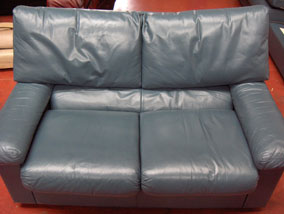
The picture above shows the sofa in its finished state. The surface of a leather sofa is often slightly shiny when new. This shine can either be enhanced by using a glossy finish, or reduced by using a matte finish. In this case, Leather Finish Satin has been used to recreate the original finish. Satin Leather Finish is neutral between matte and glossy and provides a “silky” surface. Satin is also the most common finish on leather.


